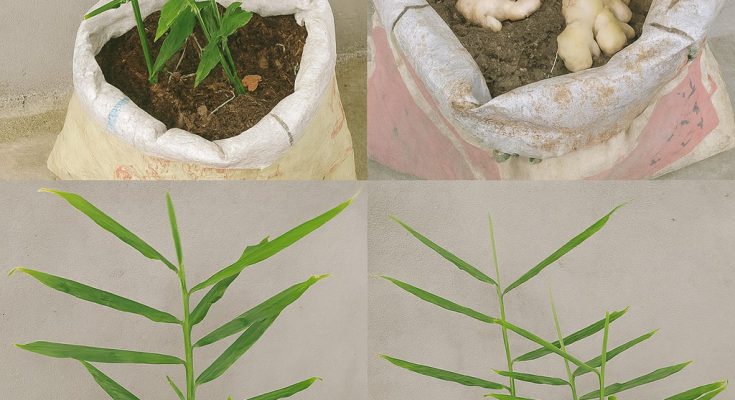Here’s a complete guide to growing ginger in buckets, right in the comfort of your home.
Why Grow Ginger at Home?
Growing ginger at home has several benefits:
-
-
Freshness: You get a steady supply of fresh ginger that tastes better than store-bought.
-
Saves money: A single rhizome can produce a generous harvest.
-
Low maintenance: Ginger is a hardy plant that grows well in containers.
-
-
Compact and attractive: Its lush, tropical leaves make it a decorative addition to your home.
If you have a warm indoor spot with indirect sunlight, you can easily grow ginger in a bucket.
What You Need to Get Started
Before planting, gather the following materials:
-
-
Fresh ginger rhizome: Look for plump, firm pieces with visible “eyes” (small growth buds).
-
-
-
A 10–15 liter bucket or container: It should be wide and shallow, as ginger grows horizontally.
-
Well-draining potting mix: A mix of compost, sand, and coconut coir or perlite is ideal.
-
Watering can or spray bottle
-
-
A sunny, warm spot indoors: Ginger likes temperatures above 20°C (68°F).
You can also start your plant outdoors if the weather is warm and bring it inside when temperatures drop.
Choosing and Preparing Ginger Rhizomes
The key to a successful ginger plant is starting with the right rhizome:
-
-
Buy organic ginger rhizomes from a garden center or a grocery store that hasn’t been treated with growth inhibitors.
-
-
Choose a piece that’s at least 2–3 inches long with multiple “eyes.”
-
Soak the rhizome in warm water overnight to encourage sprouting.
If the rhizome is large, you can cut it into smaller pieces, as long as each one has at least one eye. Let the cut ends dry for a day to form a protective callus before planting.
Planting Ginger in Buckets
-
-
Prepare the bucket: Make sure it has good drainage holes. Place a layer of small stones or gravel at the bottom if needed.
-
Fill with soil: Add 4–6 inches of moist, well-draining potting mix.
-
-
Plant the rhizome: Lay the rhizome flat on the surface, with the eyes facing up. Cover it with 1–2 inches of soil.
-
Water lightly: Use a spray bottle or watering can to gently moisten the soil.
Place the bucket in a warm, bright location, but avoid direct sunlight. Ginger prefers filtered light or partial shade, especially in hot climates.
Caring for Your Ginger Plant
Ginger grows slowly but steadily. Here’s how to keep it healthy:
-
-
Watering: Keep the soil consistently moist but not soggy. Reduce watering slightly in winter.
-
Humidity: Ginger prefers a humid environment. Mist the plant regularly or place the bucket on a tray of pebbles and water to boost humidity.
-
Feeding: Apply a liquid organic fertilizer every 3–4 weeks. A compost tea or seaweed-based fertilizer works well.
-
-
Mulching: Add a light layer of mulch (like dried leaves or straw) to retain moisture and keep the soil temperature stable.
You’ll see shoots begin to emerge within 3–5 weeks. Ginger leaves resemble bamboo and add a lush look to indoor spaces.
Harvesting Your Ginger
Ginger is typically ready to harvest in 8–10 months, but you can harvest small pieces (called “green ginger”) as early as 4–5 months.
-
-
Partial harvest: Gently dig around the edges of the bucket and break off a piece of the rhizome. Refill the soil and allow the plant to continue growing.
-
-
Full harvest: When the leaves begin to yellow and die back, it’s time to harvest the entire plant. Gently remove the rhizome, shake off the soil, and let it dry in a cool, shaded area for a few days.
You can save a few rhizome pieces with eyes and replant them to keep your ginger supply going year-round.
Tips for Success
-
-
Rotate your container occasionally so all sides of the plant get even light.
-
Avoid overwatering, which can cause root rot.
-
Don’t crowd the rhizomes when planting—give them room to spread horizontally.
-
-
Use organic methods to prevent pests like spider mites or fungus gnats. Neem oil spray is a safe, effective option.
Final Thoughts
Growing ginger in a bucket is a simple, satisfying way to bring fresh ingredients into your kitchen—even if you live in a small apartment or have limited outdoor space. With a little care and patience, you can enjoy fragrant, homegrown ginger straight from a sunny corner of your home.
It’s not just a culinary delight—it’s also a fun and rewarding experience that adds life to your indoor garden. Try it once, and you might never go back to store-bought ginger again.
